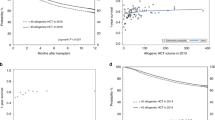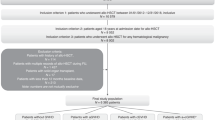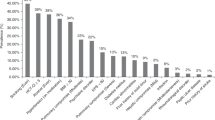Summary:
National utilization data for hematopoietic stem-cell transplantation (HSCT) for childhood cancers in the United States have not been reported. We identified cancer encounters for children aged 18 years and younger from 1997 to 2001 in US nonfederal, acute care hospitals. We compared patient, hospital, and resource use characteristics and in-patient mortality associated with HSCT and non-HSCT encounters, estimated the number of HSCT encounters by stem-cell source and cancer type, and examined resource use and mortality in each category. We identified 461 175 cancer encounters, of which 6380 (1.4%) were HSCT encounters. There was wide variation in resource use and mortality by stem-cell source and cancer type. Of note, 17% of HSCT encounters were for patients with acute lymphoblastic leukemia without remission or sarcoma, conditions for which there is little evidence of benefit from HSCT in children. These encounters were associated with high in-patient mortality and long lengths of stay. Also, we observed an increasing use of cord blood over the study period. Future research should examine potentially important sociodemographic differences in patients undergoing HSCT compared to those who do not. Additional analyses incorporating disease stage and severity are needed.
This is a preview of subscription content, access via your institution
Access options
Subscribe to this journal
Receive 12 print issues and online access
$259.00 per year
only $21.58 per issue
Buy this article
- Purchase on Springer Link
- Instant access to full article PDF
Prices may be subject to local taxes which are calculated during checkout
Similar content being viewed by others
References
Appelbaum FR . The current status of hematopoietic cell transplantation. Annu Rev Med 2003; 42: 491–512.
Woolfrey AE, Anasetti C, Storer B et al. Factors associated with outcome after unrelated marrow transplantation for treatment of acute lymphoblastic leukemia in children. Blood 2002; 99: 2002–2008.
Eden OB . Acute lymphoblastic leukaemia: whom and when should we transplant? Pediatr Transplant 1999; 3 (Suppl. 1): 108–115.
Borgmann A, Von Strackelberg A, Hartmann R et al. Unrelated donor stem cell transplantation compared with chemotherapy for children with acute lymphoblastic leukemia in a second remission: a matched-pair analysis. Blood 2003; 101: 3835–3839.
Knechntli CJ, Goulden NJ, Hancock JP et al. Minimal residual disease status before allogeneic bone marrow transplantation is an important determinant of successful outcome for children and adolescents with acute lymphoblastic leukemia. Blood 1998; 92: 4072–4079.
Bleakley M, Lau L, Shaw PJ et al. Bone marrow transplantation for pediatric AML in first remission: a systematic review and meta-analysis. Bone Marrow Transplant 2002; 29: 843–852.
Woods WG, Neudort S, Gold S et al. A comparison of allogeneic bone marrow transplantation, autologous bone marrow transplantation, and aggressive chemotherapy in children with acute myeloid leukemia in remission: a report from the Children's Cancer Group. Blood 2001; 97: 56–62.
Fung HC, Stein A, Slovak M . A long-term follow-up report on allogeneic stem cell transplantation for patients with primary refractory acute myelogenous leukemia: impact of cytogenetic characteristics on transplantation outcome. Biol Blood Marrow Transplant 2003; 9: 766–771.
Biggs JC, Horowitz MM, Gale RP et al. Bone marrow transplants may cure patients with acute leukemia never achieving remission with chemotherapy. Blood 1992; 80: 1090–1093.
Michel G, Rocha V, Chevret S et al. Unrelated cord blood transplantation for childhood acute myeloid leukemia: a Eurocord Group analysis. Blood 2003; 102: 4290–4297.
Godder KT, Hazlett LJ, Abhyankar SH et al. Partially mismatched related-donor bone marrow transplantation for pediatric patients with acute leukemia: younger donors and absence of peripheral blasts improve outcome. J Clin Oncol 2000; 18: 1856–1866.
Aladjidi N, Auvrignon A, Leblanc T et al. Outcome in children with relapsed acute myeloid leukemia after initial treatment with the French Leucemie Aique Myeloide Enfant (LAME) 89 / 91 protocol of the French Society of Pediatric Hematology and Immunology. J Clin Oncol 2003; 21: 4377–4385.
Thomson BG, Robertson KA, Gowan D et al. Analysis of engraftment, graft-versus-host disease, and immune recovery following unrelated donor cord blood transplantation. Blood 2000; 96: 2703–2711.
Stram DO, Matthay KK, O'Leary M et al. Consolidation chemoradiotherapy and autologous bone marrow transplantation vs continued chemotherapy for metastatic neuroblastoma: a report of two concurrent Children's Cancer Group studies. J Clin Oncol 1996; 14: 2417–2426.
Dunkel IJ, Finlay JL . High-dose chemotherapy with autologous stem cell rescue for brain tumors. Crit Rev Oncol Hematol 2002; 41: 197–204.
Schmitz N, Pfistner B, Sextro M et al. Aggressive conventional chemotherapy compared with high-dose chemotherapy with autologous haemopoietic stem-cell transplantation for relapsed chemosensitive Hodgkin's disease: a randomized trial. Lancet 2002; 359: 2065–2071.
Bureo E, Ortega JJ, Munoz A et al. Bone marrow transplantation in 46 pediatric patients with non-Hodgkin's lymphoma. Spanish Working Party for Bone Marrow Transplantation in Children. Bone Marrow Transplant 1995; 15: 353–359.
Meyers PA, Krailo MD, Ladanyi M et al. High-dose melphalan, etoposide, total-body irradiation, and autologous stem-cell reconstitution as consolidation therapy for high-risk Ewing's sarcoma does not improve prognosis. J Clin Oncol 2001; 19: 2812–2820.
Shankar AG, Ashley S, Craft AW et al. Outcome after relapse in an unselected cohort of children and adolescents with Ewing sarcoma. Med Pediatr Oncol 2003; 40: 141–147.
Weigel BJ, Breitfeld PP, Hawkins D et al. Role of high-dose chemotherapy with hematopoietic stem cell rescue in the treatment of metastatic or recurrent rhabdomyosarcoma. J Pediatr Hematol Oncol 2001; 23: 272–276.
Kalambakas SA, Moore TB, Feig SA . Megatherapy and stem cell transplantation for Ewing's family of tumors: a critical review of the current literature. Pediatr Transplant 2004; 8 (Suppl. 5): 83–88.
Horowitz MM, Rowlings PA . An update from the International Bone Marrow Transplant Registry and the Autologous Blood and Marrow Transplant Registry on current activity in hematopoietic stem cell transplantation. Curr Opin Hematol 1997; 4: 395–400.
McNeil DE, Cote TR, Clegg L et al. SEER update of incidence and trends in pediatric malignancies: acute lymphoblastic leukemia. Med Pediatr Oncol 2002; 39: 554–557.
Ries LAG, Smith MA, Gurney JG et al (eds). Cancer Incidence and Survival Among Children and Adolescents: United States SEER Program 175-1995. National Cancer Institute: Bethesda, MD, 1999 (NIH Pub. No. 99-4649).
Beatty PG, Kollman C, Howe CW . Unrelated-donor marrow transplants: the experience of the National Marrow Donor Program. Clin Transplant 1995; 9: 271–277.
Horowitz MM, Loberiza FR, Bredeson CN et al. Transplant registries: guiding clinical decisions and improving outcomes. Oncology 2001; 15: 649–659.
Goldman JM, Horowitz MM . The international bone marrow transplant registry. Int J Hematol 2002; 76 (Suppl. 1): 393–397.
Gratwohl A, Passweg J, Baldomero H et al. Blood and marrow transplantation activity in Europe 1997. Bone Marrow Transplant 1999; 24: 231–245.
Gratwohl A, Baldomero H, Horisberger B et al. Current trends in hematopoietic stem cell transplantation in Europe. Blood 2002; 100: 2374–2386.
Pession A, Rondelli R, Paolucci P et al. Hematopoietic stem cell transplantation in childhood: report from the bone marrow transplantation group of the Associazione Italiana Ematologia Oncologia Pediatrica (AIEOP). Haematologica 2000; 85: 638–646.
Mitchell JM, Meehan KR, Kong J et al. Access to bone marrow transplantation for leukemia and lymphoma: the role of sociodemographic factors. J Clin Oncol 1997; 15: 2644–2651.
Iezzoni LI . Assessing quality using administrative data. Ann Intern Med 1997; 27: 666–674.
Romano PS . Can administrative data be used to compare the quality of health care? Med Care Rev 1993; 50: 451–477.
Healthcare Cost and Utilization Project. Agency for Healthcare Research and Quality: Overview of the Nationwide Inpatient Sample. Available at: http://www.hcup-us.ahrq.gov/nisoverview.jsp,accessed March 18, 2005.
Healthcare Cost and Utilization Project. Agency for Healthcare Research and Quality: Introduction to the HCUP Nationwide Inpatient Sample (NIS) 2002 Available at: http://www.hcup-us.ahrq.gov/db/nation/nis/reports/NIS_2001_Design_Report.pdf, accessed March 18, 2005.
Health Care Cost and Utilization Project. Agency for Healthcare Research and Quality: Calculating Nationwide Inpatient Sample Variances, March 19, 2004. Available at: http://www.hcup-us.ahrq.gov/db/nation/nis/reports/Calculating_NIS_Variances.pdf,accessed March 18, 2005.
Goldman FD, Rumelhart SL, DeAlacron P et al. Poor outcome in children with refractory / relapsed leukemia undergoing bone marrow transplantation with mismatched family member donors. Bone Marrow Transplant 2000; 25: 943–948.
Du X, Goodwin JS . Patterns of use of chemotherapy for breast cancer in older women: findings from Medicare claims data. J Clin Oncol 2001; 19: 1455–1461.
Cooper GS, Virnig B, Klabunde CN et al. Use of SEER–Medicare data for measuring cancer surgery. Med Care 2002; 40 (Suppl. 8): IV-43–IV-48.
Virnig BA, Warren JL, Cooper GS et al. Studying radiation therapy using SEER–Medicare-linked data. Med Care 2002; 40 (Suppl. 8): IV-49–IV-54.
Warren JL, Harlan LC, Fahey A et al. Utility of the SEER–Medicare data to identify chemotherapy use. Med Care 2002; 40 (Suppl. 8): IV-55–IV-61.
Acknowledgements
We thank Damon Seils for editorial assistance and manuscript preparation.
Author information
Authors and Affiliations
Corresponding author
Rights and permissions
About this article
Cite this article
Radeva, J., VanScoyoc, E., Smith, F. et al. National estimates of the use of hematopoietic stem-cell transplantation in children with cancer in the United States. Bone Marrow Transplant 36, 397–404 (2005). https://doi.org/10.1038/sj.bmt.1705077
Received:
Accepted:
Published:
Issue Date:
DOI: https://doi.org/10.1038/sj.bmt.1705077



